Advertising
Living Disconnected – Myth or Reality? - Part 1
Posted on Apr 19, 2016
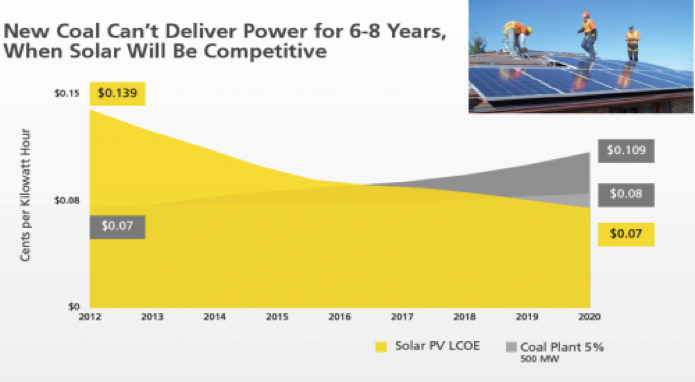
by Andrei Adam & Aidan Lehal
Contents
3.1 Benefits of Disconnecting and Producing Electricity Renewably.
3.2 Brief History of Solar Panels.
3.4 Photovoltaic (PV) System Evolution.
3.5 Examples of Solar-Sufficient homes.
3.6 Other Background Research.
6.2 Sunlight Received Seasonally.
6.4 Roof Space Available For Solar Panels.
6.10 Costs and Investment Return.
8. Discussion and Applications.
9.1 Exploring the Possibility of Supplying Excess Electricity to the Grid.
1. Abstract
Imagine living disconnected. You would reject electricity produced from the dirty power plants and instead produce your own power in a clean and renewable way. You would stop being vulnerable to electrical grid failures and rising electrical bills. To be disconnected would mean to be a part of the renewable revolution.
But is that possible? The purpose of our study was to see if solar technology has gotten to the point where we can disconnect from the electrical grid but still manage to supply all our previous electrical consumption. We hypothesized that it is possible to go off the grid without having to suffer any lifestyle changes or financial deficits in the long run.
Through comparing the consumption of our house throughout 2015 with how much electricity could be produced and stored with a PV system installed in our home (which includes solar panels, battery, inverter and backup generator) we found out if we could supply all our electrical needs. Through the comparison of the costs of the PV system to the financial benefits of disconnecting from the grid we were able to see if living disconnected is myth or reality.
The conclusion which we came to was that we could power our home through solar panels without sacrificing our lifestyle for the whole 30 year lifespan of the PV system. From the financial standpoint the costs of the PV system were almost double that of the electrical bill savings through 30 years, but the value which the system adds to your home makes going off-grid a smart investment.
Now that we have done the research, will you join the revolution and live disconnected?
2. Research Question
Is disconnecting from the electrical grid and instead creating your own electricity cleanly and renewably through solar panels installed on the roof of your house a feasible and worthwhile investment in a typical GTA household?
3. Background Research
3.1 Benefits of Disconnecting and Producing Electricity Renewably
There are three major advantages of disconnecting from the electrical grid and producing your own electricity through solar panels.
The first of such is that you are producing your own electricity cleanly and renewably. The majority of the electricity from the grid is produced in large plants which pollute the environment and release toxic chemicals in the atmosphere. By drawing power from your own solar panels, you are producing your electricity with zero emissions and guaranteeing that you will have electricity for future years as the sun will always shine. This way, you are doing your part in ensuring that your grandchildren and their grandchildren have breathable air and sustainable energy for years to come.
The second big advantage is the financial aspect. The PV system is installed at a one-time cost plus insignificant maintenance costs throughout its lifespan. These spendings are recovered through electrical bill savings as you are not buying electricity; you are producing your own. This effect is multiplied as in the next 30 years electrical bills are set to increase by at least 3% a year, costs which will not affect you being off the grid. In addition to this, the value of your home is set to rise with the installation of solar panels as buyers are looking for homes that are not polluting the environment and can produce their own electricity. If you chose to sell your house the added value brought by the solar panels usually amount to the cost you paid and usually more.
The benefits do not just end there. Any home connected to the electrical grid faces times when the grid fails, leaving the house without electricity for any possible amount of hours. By installing a PV system and disconnecting from the grid, this scenario is nearly impossible as you have electricity being produced whenever there is sunlight and energy being stored for when there is not. This guarantees that your home will continue to have power even when the houses connected to the grid around you do not.
With all these advantages of going off the grid and powering your home with solar panels, the motives to disconnect are there. We are here to research if it is even possible to capitalize on these advantages due to financial and consumption factors. If it is possible, then living disconnected will provide advantages to everyone, from the homeowner to the environment.
3.2 Brief History of Solar Panels
1839 – The Photovoltaic Effect
The basic principles of solar power were uncovered when Edmond Bequerel discovered that when light fell upon two electrodes which were placed in an electrolyte (electricity-conducting solution), a voltage developed.
1876 – Electricity from Light
A professor and his student found that selenium produced electricity when exposed to light. This proved that electricity could be generated without moving parts from light, even if there was not enough electricity to power anything.
1883 – The First Working Solar Cell
After applying selenium to a thin layer of gold American inventor Charles Fritts developed the first solar cell which had 1% efficiency. It was impractical for general use.
1954 – A Major Breakthrough
Three researchers at Bell Labs discovered silicon solar cells. The scientists presented their ‘solar battery’ operating at an efficiency of 6%. This first solar cell was the size of a small coin, and although not commercially viable, is the basis for solar cell development ever since.
1956 — 213 Truman N.E., Albuquerque, NM
In the mid-50s, engineer Don Paxton and architect Frank Bridgers designed the world’s first commercial solar building. Using a south-facing glass wall tilted to 30 degrees, alongside mechanical and “passive” solar technologies, the structure was very advanced for its time. Relying on mechanical solutions they achieved a remarkable level of efficiency through solar heating and thermal storage.
1970s – Commercial Viability
In the early 70s, Dr. Elliot Berman designed a solar cell using lower-grade silicon and cheaper housings bringing cost per watt down from $100 to $20.
1978 – First Feed-In Tariff Implemented
The first form of feed-in tariff was implemented in the US in 1978 after the signing of the National Energy Act (NEA). Its purpose was to encourage energy conservation and the development of renewable energy sources.
1990s – Dawn of the Grid
First grid-supported photovoltaic system is completed and installed in Kerman, California by Pacific Gas & Electric, the world’s first ‘distributed power’ effort.
1999 – 32.3% Efficiency is achieved
1999 — 100,000 Solar Roofs Program Starts in Germany
A “100,000 Solar Roofs” program was started in Germany with the goal of creating a PV power capacity of 300 MW within six years.
2000s — Largest Residential Solar Installation Complete producing 12 kWh of energy
2007 — 42.8% efficiency is achieved in solar panels
2016 - Living Disconnected
Study is performed by us to see if solar panels have reached the point where they could power a house which is disconnected from the electrical grid without sacrificing the homeowner’s lifestyle or money.
3.3 Types of Solar Panels
Crystalline Silicon (c-Si)
Almost 95% of today’s solar panels produced are crystalline silicon solar panels. There are different forms and types of c-Si solar panels which vary based on the purity and alignment of the silicone. The purer and better aligned the silicone is, the higher the efficiency of converting sunlight to electricity. C-Si solar panels have high efficiency and are one of the best types to put on a house with limited space.
Monocrystalline Silicon (mono-Si)
Monocrystalline silicon cells are made out of silicon ingots in a cylindrical shape. The advantage of mono-Si solar panels is that they are made out of the highest-grade silicon resulting in the highest efficiency (usually around 15-20%). Because of this they take up the least amount of space to produce the same amount of electricity and they also have the best low-light power outputs. These advantages come at a cost however. This type of solar panels is the most expensive and when placed in shade the whole circuit can break down.
Polycrystalline Silicon (p-Si)
The p-Si solar panels are very similar to the mono-Si ones; however, they are built in a simpler fashion, are cheaper and produce less waste during production. The efficiency, however, is down to 13-16% due to the use of less pure silicon, which results in lower space efficiency.
Thin Film
Prototypes have reached an efficiency of 7-13% and are easy to mass-produce and can be flexible allowing them to be placed in more places. Their cost per watt is the cheapest of the four types of solar panels mentioned, however, they are not space efficient and degrade faster than the solar panels mentioned above.
There are many other types of solar panels in production or in development today; however, very few are actually used at this time as they provide fewer benefits over the ones mentioned above. In the future, as the research and technology evolves, we are sure that higher efficiency panels such as multi-junction cells will come into commercial operation at lower cost than those that exist today.
3.4 Photovoltaic (PV) System Evolution
According to Swanson's Law, which is based on the observation that the price of solar photovoltaic modules tends to drop 20 percent for every doubling of cumulative shipped volume, at present rates, costs halve about every 10 years.
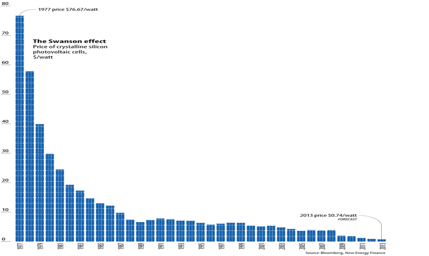
Since 1977, the cost per watt produced by solar panels has decreased by over 100 times, making now the best time than ever to invest.
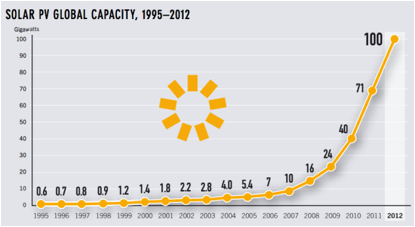
The amount of photovoltaic solar panels installed throughout the world has started to skyrocket as governments, businesses and households install solar panels - in 2014 the global capacity had risen to 183 GW.
According to Deutsche Bank, the price per watt produced by a solar system will fall by almost 40% in the next two years if development continues at the current pace.
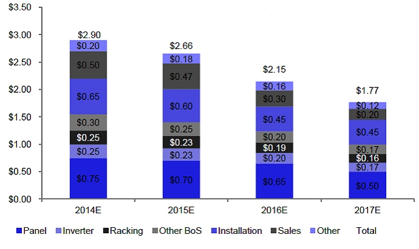
As cheaper and more efficient solar panels continue to be developed, solar panels will reach the same cost per kWh as coal plants in 6-8 years.

3.5 Examples of Solar-Sufficient homes
Our research identified only a few existing solar sufficient homes, especially in areas which have suffered days being off the grid or in isolated and disconnected regions.
One such example is a project 30 years in the making on a coastal island in Maine which is almost entirely self-sufficient. A small house powered by solar panels can generate 12V DC to provide the owners with the comforts that we experience in our own homes, including a refrigerator, lights and a water pump. However, this home is located in an isolated gorgeous location which prevents grid-connected houses to be built into the area.
Another example is in the Hudson Valley of New York, where a 12 lot subdivision of homes constructed by Blu promises to be completely off the grid, with interest coming from a broad range of people. The specific here is also its remote location where traditional houses cannot connect due to the lack of grid access. The houses use solar panels to provide electricity along with various energy-saving techniques. However, some of these techniques used are not available to be added on a pre-built house, and they must be built along with the foundation of it.
The last example comes from a couple in Manitoba who, rather than paying $60,000 to Manitoba Hydro for expansion of the grid to their location, installed solar panels for $30,000. They installed 24 solar panels which combined provide them with about 24 kWh of electricity a day. This allows the couple to go solar without sacrificing any of their regular electrical uses. In addition to the solar panels, the couple spend almost three years building their home from the ground up to be able to live their self-sufficient dream.
These are all great examples; however, they all do have slight advantages to us in southern Ontario. These examples receive more sunlight annually than us along with the fact that they managed to reduce their usage and increase energy conservation from the foundation of their house. So, with this in mind, we set out to see if it is feasible to do the same as these examples, except here, in southern Ontario.
3.6 Other Background Research
Typical off-grid solar systems require the following components:
- Solar Panels
- Solar Panel Racking
- Charge Controller
- Battery Bank
- Wires
- DC to AC inverter
- Backup Generator (optional)
- System Installation
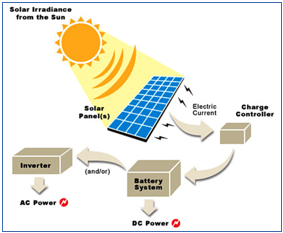
4. Hypothesis
If homeowners installed solar panels on their roofs, then they will be able to disconnect from the electrical grid, supply their own electrical consumption and make a return on their investment because the solar panels will produce enough electricity to power all the house’s electrical needs without having to worry about rising electric bills.
By doing so the adaptors will avoid using electricity produced by the big power plants, most of them polluting and using finite resources, and contribute to the environmental revolution.
5. How We Did Our Study
To investigate our hypothesis we chose to work with data from one of our houses, which is similar to the average house in the GTA.
- We determined the electrical needs of the household by analysing the hourly electricity consumption in 2015. In doing so we calculated critical parameters such as the daily average, daily maximum, hourly maximum and two day maximum energy consumption for every season.
- We calculated how many hours of sunlight the GTA receives seasonally. With that we calculated at what output efficiency solar panels work during various hours of the day for each season.
- We found how much space was available on the roof of our house on which we could install solar panels.
- We identified four of the best solar panels which we would compare throughout our project along with some of their basic information such as cost, dimensions, efficiency, etc.
- We determined how many solar panels of each type can fit on our roof and how much it would cost to buy that amount.
- We calculated the efficiency of the solar panels on each face of the roof, since the angle and cardinal orientation of the panels are critical.
- We found out how much electricity the solar panels would produce on a daily average each season in their first year of operation and in their 25th. The 25th year of operation was used for analysis.
- We sized an appropriate battery which could store sufficient energy to power the home for 4 average days without being charged.
- We identified a suitable DC to AC inverter that has the inverting capacity to supply our maximum hourly consumption.
- We determined a possible backup generator which would make sure that in a worst-case scenario our house would not remain without power.
- We looked at how much the whole system would cost to install and the operating and maintenance costs over the next 30 years, which is the average lifespan of any PV system.
- Lastly, we calculated how much money the system would save us in electrical bills over the same time period. We also looked at by how much the retail value of our home would increase by before finally comparing the costs to the savings and investment return.
- After finalizing our conclusion, discussion and applications, we decided to extend our project and research the merits of selling the excess electricity back to the grid via the FIT program or net-metering.